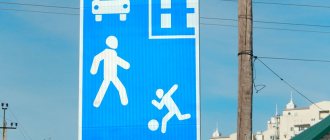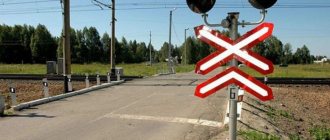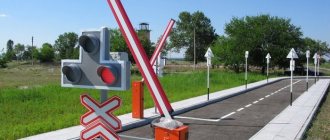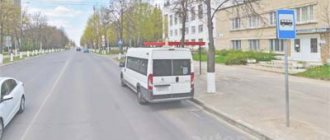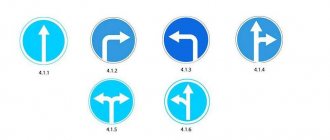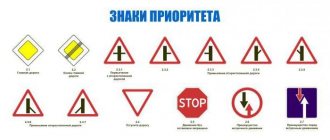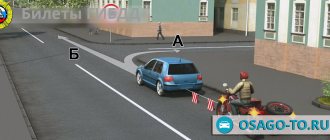These signs warn you that you are approaching:
| 1. | Towards a railway crossing without a barrier. |
| 2. | Towards a railway crossing with a barrier. |
| 3. | To the place of work on the road. |
The main sign “Railway crossing with barrier” outside populated areas is installed at a distance of 150 to 300 m before the crossing, in addition, the same sign is installed again at a distance of at least 50 m before the crossing.
“Approaching railroad crossing” signs provide additional warning that you are approaching a railroad crossing. They are used only outside populated areas.
Warning signs
- 1.1 Railway crossing with barrier
- 1.2 Railway crossing without a barrier
- 1.3.1 Single track railway
- 1.3.2 Multi-track railway
- 1.4.1 Approaching a railway crossing at a distance of 150-300 meters outside populated areas
- 1.4.2 Approaching a railway crossing at a distance of 100-200 meters outside populated areas
- 1.4.3 Approaching a railway crossing at a distance of 50-100 meters outside populated areas
- 1.4.4 Approaching a railway crossing at a distance of 150-300 meters outside populated areas
- 1.4.5 Approaching a railway crossing at a distance of 100-200 meters outside populated areas
- 1.4.6 Approaching a railway crossing at a distance of 50-100 meters outside populated areas
- 1.5 Intersection with tram line
- 1.6 Intersection of equivalent roads
- 1.7 Roundabout
- 1.8 Traffic light regulation
- 1.9 Drawbridge or ferry crossing.
- 1.10 Departure to the embankment or shore.
- 1.11.1 Dangerous right turn
- 1.11.2 Dangerous left turn
- 1.12.1 Dangerous turns with the first right turn
- 1.12.2 Dangerous turns with first left turn
- 1.13 Steep descent
- 1.14 Steep climb
- 1.15 Slippery Road
- 1.16 Rough Road
- 1.17 Artificial hump
- 1.18 Gravel release
- 1.19 Dangerous roadside
- 1.20.1 Tapering on both sides
- 1.21 Two-way traffic
- 1.22 Pedestrian crossing
- 1.23 Children
- 1.24 Intersection with a bicycle path or pedestrian path
- 1.25 Road works
- 1.26 Cattle drive
- 1.27 Wild animals
- 1.28 Falling stones
- 1.29 Side wind
- 1.30 Low-flying aircraft
- 1.31 Tunnel
- 1.32 Congestion
- 1.33 Other hazards
- 1.34.1 Direction of right turn
- 1.34.2 Left turn direction
- 1.34.3 Turn direction at T-junction
Can you outrun a tractor?
| 1. | No. |
| 2. | Yes. |
| 3. | Yes, if overtaking is completed 100 m before the crossing. |
Overtaking is prohibited at railway crossings and closer than 100 m in front of them. Since the railway crossing is located outside the populated area, the signs “Railway crossing without a barrier” and “Approaching a railway crossing” are installed at a distance of 150-300 m before the crossing. Therefore, you can start overtaking the tractor in this situation if the overtaking is completed 100 m before the crossing.
These signs warn you:
| 1. | About approaching a railway crossing with three tracks. |
| 2. | About the presence of a railway crossing without a barrier in 150-300 m. |
| 3. | About the presence of a railway crossing in 50-100 m. |
In front of you is a sign for a railway crossing without a barrier. The sign “Approaching a railway crossing” with three stripes installed underneath is only an additional warning about approaching the crossing. Outside populated areas, this combination of signs is installed at a distance of 150 to 300 m before the crossing.
What signs are installed immediately before a railway crossing?
In the immediate vicinity of the railway crossing, signs indicating the type of railway tracks are installed.
Sign 1.3.1 indicates that there is a single-track (single-track) road ahead. This means that only one train can travel on a given railway track in one direction.
Single track railway is less dangerous. If the train has passed, then movement can begin subject to permitting signals.
Sign 1.3.2 means that there is a multi-track road ahead. The driver must be extremely careful, since the train can come from any direction.
This sign warns drivers that if a train has passed but the traffic light has not turned green, they cannot start driving. There is a possibility that the train will go from the other side.
Several more signs are installed 200 meters or less before the dangerous area if the paths are located outside the city.
Signs 1.4.1-1.4.6 indicate the approach of tracks where trains and trains pass.
The number of lanes means how many meters are left before the crossing:
Signs 1.4.1, 1.4.2, 1.4.3 with an oblique line directed to the right are installed on the right side of the road. Accordingly, 1.4.4, 1.4.5, 1.4.6 are installed on the left side of the roadway in the direction of travel of the car.
At each interval, certain safety rules apply, which must be taken into account by the driver to safely cross the tracks.
Another sign number 2.5 “No stopping without stopping.” It means that the driver is obliged to stop the car in front of the sign and make sure it is safe to drive.
It is necessary to give way to vehicles moving along the line being crossed, in this case a train or locomotive.
The stop does not last more than 2 minutes. This is enough to assess the situation and check that there is no approaching train. This sign is installed at controlled and unregulated crossings, mainly near traffic lights.
Without barrier
In the area of unregulated railway crossings, sign 1.2 is installed. It means that ahead you have to cross the railway tracks without a barrier. As a rule, such signs are found in sparsely populated areas.
The sign is installed twice:
Double installation of the sign is necessary for those drivers who missed the first signal about approaching the railway crossing. This also means that there is a difficult section of the road ahead, where you need to be attentive and very vigilant.
In urban areas, crossings without barriers are very rare. Low-speed trains are allowed to pass through them infrequently. Sign 2.5 is installed only once in the city - 50-100 meters before the crossing.
Outside populated areas, the sign is installed twice and can be supplemented with other signals: traffic lights, sound installations. They are necessary if the road section is dangerous, and trains often pass along the tracks.
Unregulated multi-track railways deserve special attention. When the train has passed, you need to make sure that the train is not heading from the other direction. Only after making sure the path is safe can you start moving.
With barrier
Regulated railway tracks are determined by sign 1.1. It means that there is a railway with a barrier ahead. This sign is usually supplemented by a traffic light and an installation with sound signals.
The operation of the barrier is regulated by the person on duty or the barrier devices are turned on automatically.
The sign is installed once in a populated area. Outside the city limits, the sign is installed twice.
Read about turning around at a railway crossing here.
What signs are installed immediately before a railway crossing?
| 1. | Only A. |
| 2. | Only B. |
| 3. | Only in. |
| 4. | A and B. |
Answer
| Sign B “Multi-track railway” is installed closest to the railway crossing. It is placed in front of railway crossings without a barrier on the same support as traffic lights, and in their absence, at a distance of at least 20 m from the nearest rail. |
| Signs A “Railway crossing with a barrier” and “Approaching a railway crossing” are installed only on roads outside populated areas at a distance of at least 50 m from the dangerous area. |
| Signs B “Railway crossing without a barrier” and “Approaching a railway crossing”, respectively, 150-300 m before it. |
The correct answer is Only B.
Signs marking the entrance to a railway crossing.
1.1 “Railway crossing with barrier.”
Approaching a railway crossing equipped with a barrier. The driver is obliged to reduce speed and assess the situation. This sign is repeated only outside the populated area; the second sign is installed at a distance of at least 50 m before the start of the dangerous section.
1.2 “Railway crossing without a barrier.”
Approaching a railway crossing that is not equipped with a barrier. The driver is obliged to reduce speed and assess the situation. This sign is repeated only outside the populated area; the second sign is installed at a distance of at least 50 m before the start of the dangerous section.
Signs 1.1 “Railway crossing with a barrier” and 1.2 “Railway crossing without a barrier” are installed in front of all railway crossings, respectively equipped or not equipped with barriers. Signs are duplicated on roads with two or more lanes for traffic in one direction, and on roads with one lane if the visibility distance of the crossing outside populated areas is less than 300 m, and in populated areas - less than 100 m.
If the distance between railway crossings is 50 m or less, signs are installed before the first crossing, and if the distance is more than 50 m, before each crossing.
A = from 150 to 300 m; C = at least 50 m;
1.3.1 “Single-track railway”, 1.3.2 “Multi-track railway”. Designation of a railway crossing not equipped with a barrier:
1.3.1 – with one path, 1.3.2 – with two paths or more.
Signs 1.3.1 “Single-track railway” and 1.3.2 “Multiple-track railway” are installed immediately in front of all railway crossings without a barrier, respectively, across a railway with one or two or more tracks. If there is a traffic light signal at the crossing, the signs are installed on the same support as the traffic light, and if there is none, at a distance of 6-10 m from the nearest rail.
Drivers are warned about the presence of a single-track railroad crossing that is not equipped with a barrier. The driver is obliged to reduce speed and assess the situation.
If there is a 2.5 sign, you must stop, regardless of whether there is a train or not.
1.4.1 – 1.4.6 “Approaching a railway crossing.” Additional warning about approaching a railway crossing outside of populated areas.
| 1.4.1 | Approaching a railway crossing | Additional warning about approaching a railway crossing outside populated areas. This sign can be installed simultaneously on the right and left sides of the road (the inclined red stripe is directed towards the roadway) 150-300 meters away. |
| 1.4.2 | Approaching a railway crossing | Additional warning about approaching a railway crossing outside populated areas. This sign can be installed simultaneously on the right and left sides of the road (the inclined red stripe is directed towards the roadway) 100-200 meters away. |
| 1.4.3 | Approaching a railway crossing | Additional warning about approaching a railway crossing outside populated areas. This sign can be installed simultaneously on the right and left sides of the road (the inclined red stripe is directed towards the roadway) 50-100 meters away. |
| 1.4.4 | Approaching a railway crossing | Additional warning about approaching a railway crossing outside populated areas. This sign can be installed simultaneously on the right and left sides of the road (the inclined red stripe is directed towards the roadway) 150-300 meters away. |
| 1.4.5 | Approaching a railway crossing | Additional warning about approaching a railway crossing outside populated areas. This sign can be installed simultaneously on the right and left sides of the road (the inclined red stripe is directed towards the roadway) 100-200 meters away. |
| 1.4.6 | Approaching a railway crossing | Additional warning about approaching a railway crossing outside populated areas. This sign can be installed simultaneously on the right and left sides of the road (the inclined red stripe is directed towards the roadway) 50-100 meters away. |
Signs 1.4.1-1.4.6 “Approaching a railway crossing” are installed outside populated areas on roads with two or more lanes for traffic in both directions before each crossing, and on roads with one lane - when the visibility distance of the crossing is less than 300 m.
Signs 1.4.1-1.4.3 are installed on the right side of the road, and signs 1.4.4-1.4.6 - on the left. Signs 1.4.1 and 1.4.4 are installed with the first (main and backup) sign 1.1 or 1.2 in the direction of travel, signs 1.4.3 and 1.4.6 - with a second sign 1.1 or 1.2, and signs 1.4.2 and 1.4.5 - independently, at an equal distance between the first and second sign 1.1 or 1.2.
Signs 1.4.1, 1.4.3, 1.4.4 and 1.4.6 are placed under sign 1.1 or 1.2, signs 1.4.2 and 1.4.5 - at a height equal to the height of installation of signs 1.4.1, 1.4.3,1.4.4 and 1.4.6.
Signs 1.5,1.6,1.7,1.8,1.22,1.24 warn of approaching the corresponding intersections. The driver is advised to pay attention, reduce speed and take measures appropriate to the situation.
1.5 “Intersection with tram line.”
Sign 1.5 “Intersection with a tram line” is installed before the intersection of a road with tram tracks outside the intersection, as well as in front of intersections (squares) through which tram tracks pass, when the visibility distance of the tracks is less than 50 m.
Warns of approaching an intersection with tram tracks outside the intersection or before the intersection when visibility of the tram tracks is limited (less than 50 m).
The driver is obliged to reduce speed and assess the situation. Give way to the tram.
When approaching such an intersection, the driver must be especially careful, since in most cases the tram has the right of way, that is, the driver must give way to the tram, except when leaving the depot.
Source: helpiks.org
Which driver violated the parking rules?
| 1. | Both did not violate. |
| 2. | Both violated. |
| 3. | Only the driver of car B. |
| 4. | Only the driver of car A. |
Both drivers violated the Rules, since parking is prohibited within 50 m on either side of railway crossings.
Is such a maneuver allowed?
| 1. | No. |
| 2. | Yes, if there are no oncoming vehicles. |
| 3. | Yes, if the distance between the barrier and a stopped truck is 6 m. |
The driver of the truck stopped in accordance with the requirements of the Rules - no closer than 5 meters from the barrier, and passing vehicles standing in front of the crossing into oncoming traffic is prohibited.
